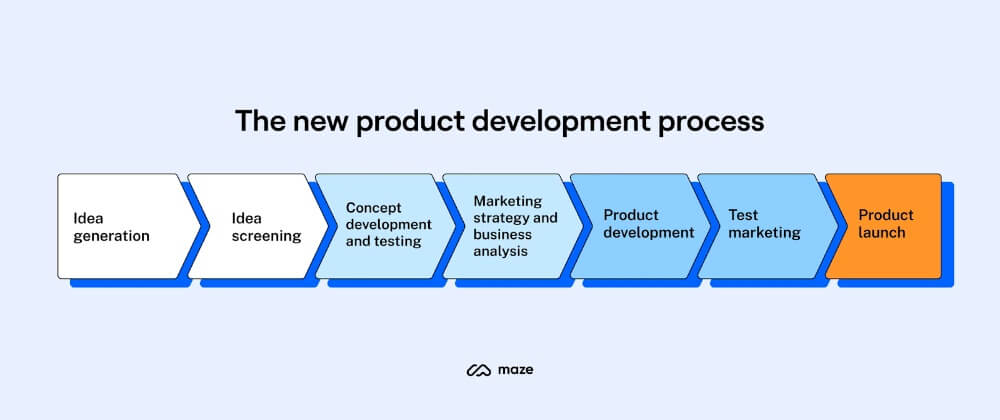
More than 95% of new products launched by established companies each year fail.
Why do you think it happens? Let’s get straight to the point. The reason is the absence of a foolproof product development marketing strategy.
When we come down to it, product marketing is critical for any firm, irrespective of size or sector. Alongside your product plan, you must integrate a smart marketing strategy that covers brainstorming, creativity, market analysis, tests, release, and post-launch.
If you do not give enough focus to each of these crucial stages, your business will fail to recuperate costs, resulting in profit losses.
So, today, in this blog, we will go through the best practices for designing an effective marketing strategy for product development.
10 Tips to design an effective marketing strategy for successful product development

Your marketing strategy should give clarity about your product, decide end goals for the product launch, finalize pricing, and ensure a good customer experience in all stages.
The road to launching a new product starts with a novel concept and a fresh product idea.
Innovative thinking is typically carried out by a cross-functional team, comprising marketers, managers, experts, and product owners.
Keeping this in mind, each product project in your firm requires a consolidated idea vault.
In your marketing efforts, you could also broaden idea generating towards your community by requesting for inputs or regular ideas.
Your marketing team may assist in selecting the appropriate channels to showcase the endeavor and ensuring a smooth flow.
The value of marketing departments during the ideation stage cannot be overstated. They can help the process in providing expertise, presenting ideas, and validating them.
Marketing teams also can offer an insight into whether a novel product will fit in the market, the means to promote it, what approaches to implement, and how to assess challenges with a market launch, among other things.
Perform market research in order to determine the new product’s target audience. Contact your prospective and existing customers to get their feedback about the concept of your new product and prioritise the importance of technology in market research.
Questionnaire surveys, chat rooms, and polls can also assist you figure out who your target audience is. You can use this information to construct buyer personas as well as user stories, which include the below-mentioned demographic information:
The average age
Geographical location
Mean earnings
Gender and marital status
Finally, you’ll be able to carry out an informative market segmentation process. You may also use a SWOT (Strengths, Weaknesses, Opportunities, and Threats) analysis to perform competitive research and identify the best method for product positioning.

It’s a great idea to describe your product prior to promoting. Customers don’t respond well to vagueness unless you have established yourself as a big brand name. Here are some questions to answer:
What is the purpose of your product?
How does it stack up against the competition?
What distinguishes your product’s values and characteristics?
After you’ve established a distinct package of advantages, you can figure out why your product is needed in the market. The cost, quality, functionality, and accessibility of your goods are the most important factors for customers.
Customer testing is the most important aspect of product marketing. Many businesses provide sneak peeks or sample groups for product testing.
Your first goal in creating your marketing strategy should be to gauge reactions, fill out questionnaires, and collect data about the utility of your product. There will be no marketing until there is a good response.
This detailed guide can assist you in identifying what is product development, the challenges and developing strategies for bringing your final product to the market.
Begin brainstorming on your product’s value proposition, which means the purpose of your offering.
Start this process after you get an idea and have a target consumer base in mind. Here are the questions you should answer:
What are the primary advantages of the product to the customer?
Is it a brand-new product concept?
Are you making changes to a current product?
You can even employ a marketing strategy that mixes product enhancement with innovation. This strategy works since it keeps a similar degree of familiarity when introducing a brand new product.
You may even try to launch a fresh functional prototype — which can be a workable prototype or a beta edition for people.
Create a landing page on your website for your new product after it has been vetted by focus groups and is well appreciated.
Include a sign-up email function to obtain more data about client preferences while also generating interest.
As new innovations arise, keep your audience updated, enthusiastic, and well-informed. Create a Facebook account and a Twitter handle for your business, and begin alerting clients about your offerings.
In the case of product development marketing, an online presence of your brand is essential for better results.
However, the effectiveness of your strategy depends on the channels that you utilize during the implementation. Multiple online marketing tools demand your focus in this case.
Is everybody in your firm aware of your product and eager to work on it?
Each employee has something to say, so pay attention. Unlikely team members can sometimes come up with the most innovative marketing ideas.
Next, planning ahead is an important aspect of every marketing strategy. How many hours and money are you prepared to devote to the launch of your novel product? Assign teams and managers to ensure that your organization meets its product launch deadlines.
Again, to gather support for your product, create content, flyers, videos, and other things. Help train a customer care network and establish a structure for warranties, maintenance, and support when the product is based on tech. Additionally, consider designing a visually appealing product flyer design that effectively communicates the features and benefits of your technology-based product to potential customers.
Thousands of new smartphone and online apps are released every year.
You realize how tough it may be in bringing a digital invention to life if you’re a digital product creator.
In most circumstances, a modern electronic gadget shall face several iterations before being made available to the general public. The easiest method to obtain a sense of how a digital product will appear and operate is to create a prototype.
With the help of this prototype, you’ll be able to tweak your concept and make it more likely to succeed once it’s released. Ignoring the necessity for a prototype might lead to a number of errors in the development cycle. These issues can cause long-term issues with functionality.
Here is a collection of expert-recommended tips on how to launch a digital prototype as a part of your marketing strategy.

Begin your product launch after your marketing plan has been formulated.
Prior to launching a product in the market, you should conduct an internal idea test as a marketing or product manager.
Product testing enables your firm to perceive any problems in the product’s design and implementation. Testing, for example, will allow you to uncover weaknesses and compatibility concerns with your product.
Your product and development team is in charge of deploying UI/UX-related tech upgrades, as well as establishing the necessary website/app infrastructure to combine promotional materials and documents.
As a result, the effectiveness of internal testing is dependent on cross-functional teams working together.
After that, you must create a pricing policy and test it before implementing it.
Is the price lower or higher than the market rate?
Will the corporation be able to recoup its costs after the sale?
Which sales funnels are most likely to produce leads and sales?
You may now exhibit the product before your focus groups and then release it to the market once you’ve settled on the price and are happy with it.
After the launch, monitoring the performance of your marketing strategy is an important aspect, especially while developing a fresh product concept.
You’ll want to keep an eye on the product’s market reach and overall success.
Monitor views, conversions, bounce rates, and additional important metrics with the required KPIs. This information will aid you in polishing your product’s marketing plan in the future.
You should form a cross-functional committee to oversee not only the development process but also customer feedback and interaction in order to make further changes. Don’t forget to get data from a variety of people via social media and customer service. For that purpose you should hire a customer service manager who ensures efficient handling of customer inquiries and complaints to maintain satisfaction and retention.
This essential success factor shall eventually make post-launch enhancements, such as upgrades and fixes, easier for your firm. The information can also be used to launch a fresh retargeting strategy for the same product.
Conclusion
To increase sales, you must develop a solid marketing strategy for your new product.
However, you must use the correct marketing strategy and adapt it as needed to meet ever-changing market demands.
In order to decrease the projected time to launch, you can also opt for a go-to-market strategy for your product.